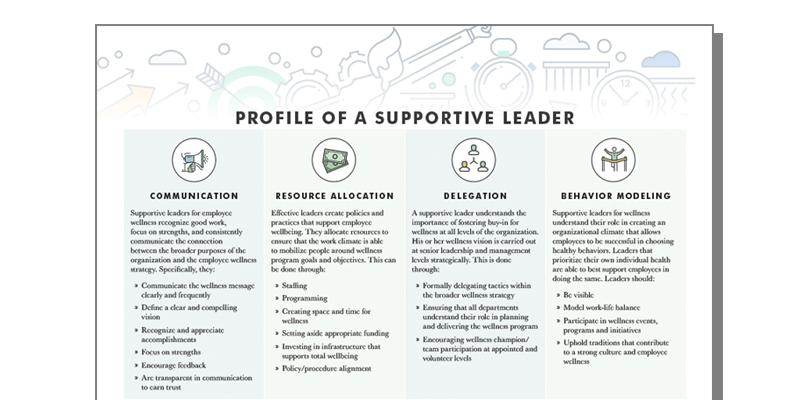Discover the 4 main characteristics of a supportive leader for successful workplace wellness programs.

Supportive leaders for employee wellness recognize good work, focus on strengths, and consistently communicate the connection between the broader purposes of the organization and the employee wellness strategy. Specifically, they:
- Communicate the wellness message clearly and frequently
- Define a clear and compelling vision
- Recognize and appreciate accomplishments
- Focus on strengths
- Encourage feedback
- Are transparent in communication to earn trust

Effective leaders create policies and practices that support employee wellbeing. They allocate resources to ensure that the work climate is able to mobilize people around wellness program goals and objectives. This can be done through:
- Staffing
- Programming
- Creating space and time for wellness
- Setting aside appropriate funding
- Investing in infrastructure that supports total wellbeing
- Policy/procedure alignment

A supportive leader understands the importance of fostering buy-in for wellness at all levels of the organization. His or her wellness vision is carried out at senior leadership and management levels strategically. This is done through:
- Formally delegating tactics within the broader wellness strategy
- Ensuring that all departments understand their role in planning and delivering the wellness program
- Encouraging wellness champion/team participation at appointed and volunteer levels

Supportive leaders for wellness understand their role in creating an organizational climate that allows employees to be successful in choosing healthy behaviors. Leaders that prioritize their own individual health are able to best support employees in doing the same. Leaders should:
- Be visible
- Model work-life balance
- Participate in wellness events, programs and initiatives
- Uphold traditions that contribute to a strong culture and employee wellness

“At WELCOA, an important part of my role is to not just define organizational priorities, but to help my team understand how investing in their own wellness helps support those objectives. No one can believe that their own wellness does not have an impact on the health of the organization; it is an imperative for our business and allows us to deliver on our mission and support those we serve.”


